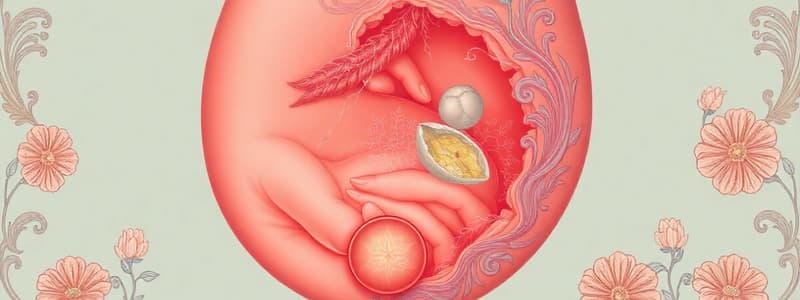Podcast
Questions and Answers
What is the primary source of maternal blood entering the intervillous space?
What is the primary source of maternal blood entering the intervillous space?
- Decidual arteries
- Umbilical arteries
- Spiral endometrial arteries (correct)
- Uterine veins
How does maternal blood exit the spiral arteries to reach the intervillous space?
How does maternal blood exit the spiral arteries to reach the intervillous space?
- Via gaps in the cytotrophoblastic shell (correct)
- Within umbilical cord vessels
- By diffusion across the chorion
- Through direct openings in the placenta
What structure in the placenta is associated with the spiral arteries?
What structure in the placenta is associated with the spiral arteries?
- Chorionic plate
- Amnion
- Cytotrophoblastic shell
- Decidua basalis (correct)
What is the role of the intervillous space in the placenta?
What is the role of the intervillous space in the placenta?
What area do the spiral arteries primarily supply?
What area do the spiral arteries primarily supply?
What characterizes the condition of placenta percreta?
What characterizes the condition of placenta percreta?
Which statement is true about a battledore placenta?
Which statement is true about a battledore placenta?
In which trimester is significant bleeding typically associated with placenta percreta?
In which trimester is significant bleeding typically associated with placenta percreta?
Which of the following conditions is specifically linked to the abnormal insertion of the umbilical cord?
Which of the following conditions is specifically linked to the abnormal insertion of the umbilical cord?
What is a primary risk associated with placenta percreta?
What is a primary risk associated with placenta percreta?
Which type of placenta is characterized by the blastocyst implanting close to or over the internal OS of the uterus?
Which type of placenta is characterized by the blastocyst implanting close to or over the internal OS of the uterus?
What is an implication of having a marginal placenta praevia?
What is an implication of having a marginal placenta praevia?
Which description accurately fits a centrali placenta praevia?
Which description accurately fits a centrali placenta praevia?
Which of the following conditions is most closely associated with improper implantation of the blastocyst in the uterus?
Which of the following conditions is most closely associated with improper implantation of the blastocyst in the uterus?
In the context of placental health, what does the term 'lateralis' indicate?
In the context of placental health, what does the term 'lateralis' indicate?
Flashcards are hidden until you start studying
Study Notes
Placenta Formation
- Maternal blood flow enters the intervillous space through the spiral endometrial arteries in the decidua basalis.
- The spiral arteries pass through gaps in the cytotrophoblastic shell, delivering blood into the intervillous space.
Placenta Percreta
- In this condition, chorionic villi invade the full thickness of the myometrium.
- This can lead to severe bleeding during the third trimester of pregnancy.
Batteldore Placenta
- The umbilical cord is attached to the edge of the placenta instead of the center.
- The embryo floats freely in amniotic fluid, suspended by the umbilical cord.
Amniotic Fluid
- Plays a crucial role in the normal development of the fetus.
- Key functions include:
- Symmetrical external growth of the embryo and fetus.
- Barrier against infection.
- Normal fetal lung development.
- Prevents adherence of the amnion to the embryo and fetus.
- Cushions the embryo and fetus from external impacts.
- Helps regulate the embryo's body temperature.
- Enables fetal movement, aiding muscular development.
- Maintains fluid and electrolyte homeostasis.
Amniotic Fluid Production
- Most of the fluid originates from maternal tissue and interstitial fluid.
- This fluid diffuses across the amniochorionic membrane from the decidua parietalis.
Twin Types
-
Dizygotic (DZ) twins:
- Result from fertilization of two separate oocytes.
- Account for approximately two-thirds of twin pregnancies.
- Rate of DZ twinning rises with maternal age and may be influenced by genetics.
-
Monozygotic (MZ) twins:
- Result from fertilization of a single oocyte, developing from one zygote.
- MZ twins are of the same sex, genetically identical, and share a very similar physical appearance.
Placenta Praevia
- The fertilized egg implants close to or over the opening of the uterus (internal OS)
- Types of placenta praevia are: centrali, marginalis, and lateralis
Placenta Accreta
- The villi of the placenta, incorrectly attach to the muscle layer of the uterus (myometrium)
- This leads to an abnormal adhesion, which can prevent the placenta from separating after birth
Placenta
- It is a temporary endocrine gland that provides a way for the baby to connect to the uterus (via the umbilical cord)
Sources of Placental Development
- The placenta develops from the chorion of the fetus and decidua basalis of the mother
Studying That Suits You
Use AI to generate personalized quizzes and flashcards to suit your learning preferences.




